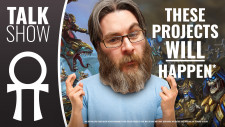Zona Alfa
Review: Zona Alpha: A review from the exclusion zone
March 5, 2020 by dracolic
Related Review Types
Supported by (Turn Off)
Supported by (Turn Off)
Author: Patrick Todoroff
Publisher: Osprey Publishing
MSRP: $20.00 US
Period/Setting: Russian Post-apocalyptic, but can be placed anywhere.
Scale: 28mm or 15mm
Basing: single figure bases.
Game Board: 3’x3’, 4'x4'
Army size per side: 4-12 figures
Primary dice: d10's and the occasional d6, rolling low is good during the game. On salvage rolls high is better.
Overview:
These rules are themed around the S.T.A.L.K.E.R or Metro series of video games; or the novel Roadside Picnic. If you are not familiar with any of those; then picture a Soviet-era town that is beginning to decay and is mostly abandoned. The game takes place in an Exclusion Zone; which is an area that has been cordoned off from the rest of the world. Your team is one of many that head into the “zone" in order to explore and salvage any anomalies they may find. There are many exclusion zones scattered around the globe, so you can use whatever terrain you have available for your own games.
When preparing for a game each side creates a force that has 12 activations or Khrabrost’. Each figure will have between 1 and 3 actions. This corresponds to them being either a rookie, hardened, or a veteran. Your leader is a veteran and will cost you 3 of your starting 12. The nine remaining Khrabrost' can be used however you want to equal 12. This allows people to either make a force of a few elites or a swarm of raw recruits, or anything in-between. When you add to your force after the initial creation, you must spend you hard earned rewards and this might let you have more or less than the 12 activations in later games. It is important to know that figures are WYSIWYG(What You See Is What You Get) and this can lead to a group all being armed with grenade launchers or LMG's. Thankfully, these bigger weapons come with drawbacks like limited ammo and/or slowing you down.
During set up, one main objective is placed in the center and a number of hot zones are placed around the board. These hot spots are searchable areas that spawn a random encounter and salvage. These extra areas offer extra resources and allow for some gains even if you do not win the mission.
After the mission you have to pay 10% of your salvage to your faction. With the remainder you can buy items, equipment and new members in order to improve your squad for the next mission.
The book:
This book is part of the Osprey blue book series and comes in at the usual 64 pages. The artwork is of the typical Osprey quality. Most pages also have a small picture of a vignette with some very flavorful text to get you in the mood and also allowing for some great inspiration for tables.
The book follows the same basic format of other books in this series. You start off with a nice table of contents to find you almost anything you want. They are never as nice as a proper index, but they break down each chapter to bring you right to the section you want.
After a brief introduction on the setting, the book covers the essentials of what you need to play. This includes a really nice list of companies that make appropriate figures for the game. Following the introduction is a quick section covering the stats used for each figure and their weapon.
The third section covers all the actions you can take, like searching and shooting. This section also includes movement and cover.
The fourth section covers combat and wounds. I really like how close combat works in this game. Both parties roll to see how many hits they each get; then the attacker can choose to cancel hits from the defender with their own hits. The unusual part of this book is that the rules for cover are found in the third section and not the section for combat.
The armory is found in the fifth section and it covers weapons, grenades and armor. There are tables for most everything. The armor is the only one that does not have a table, they are just listed out in on the subsection and I found this a bit difficult to find when quickly flipping through and looking for the stats for armor.
Skills, abilities and equipment are next in the book. Each character has between 0 and 2 skills dependent on rank. These are freely chosen to ensure each figure gas the best skills for their role in the squad. After the skills are the equipment lists, and they include such items as gas masks and red dot sights.
In the seventh section you are walked through how to build your squad and select the starting weapons, gear and skills. Then you can pick a faction you will support. Factions give bonuses like discounts or free gear when you select them. Your faction of choice will determine the initial reactions when you encounter other teams on the battlefield. This is another aspect of the game that I find really unique and adds some options instead of direct conflict.
Section eight is the largest single section in the book and it covers the mission options that are determined pregame. Be aware that the further into the zone you venture the more dangerous it gets; but the rewards are also greater. How confident are you in your team? After the mission has ended you move to The Stalls in order to rest and refit and the cost for weapons, armor, gear and recruits are found here, yet the stats for everything can be found in the corresponding earlier sections. I found this an odd choice to break up the costs from stats, but it is not that difficult of a hurdle to overcome.
Since Zona Alfa is geared towards narrative and campaign play, the ninth and tenth sections cover this topic. The ninth section covers how to set up and end a campaign. A sample campaign is given in the 10th section, and these are the only actual missions you will find in the book. You are expected to come up with your own stories and narratives for games.
Final Thoughts:
This book offers a good narrative game set in a more modern post-apocalyptic environment. Creating your force is quick since your gear is pretty much what you have on each figure. There are a lot of vignettes in the book that do a wonderful job of setting the mood for the in game universe. Patrick did a good job getting a full game into 64 pages and he has been active online supporting the players and answering questions. He is apparently working with Osprey to post a document that can help make the game smoother for solo play. I found that some of the information is in some odd locations and can cause some slow downs until you are familiar with the rules . There is a Quick Reference Sheet available and keeps everything in one location.

































![How To Paint Moonstone’s Nanny | Goblin King Games [7 Days Early Access]](https://images.beastsofwar.com/2024/12/3CU-Gobin-King-Games-Moonstone-Shades-Nanny-coverimage-225-127.jpg)









Leave a Reply